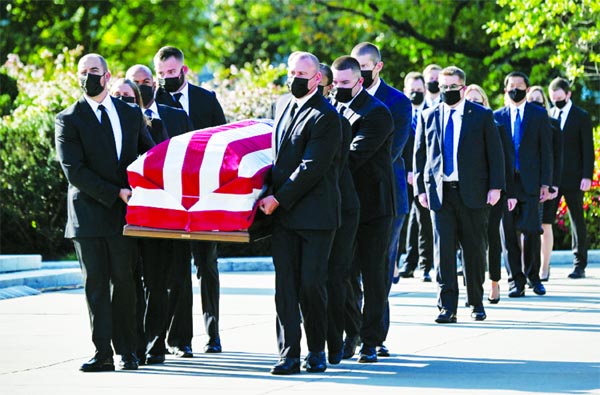
Associate Justice Ruth Bader Ginsburg returned to the Supreme Court for the final time Wednesday under circumstances both she and her legions of liberal allies and admirers hoped would never happen.
Even as President Donald Trump readied a potential replacement for the late justice, who died Friday after a lengthy battle with cancer, Ginsburg’s family, friends, former law clerks and colleagues on the high court gathered for one last goodbye.
The flag-draped casket of the 87-year-old justice was carried up the stairs to the Supreme Court’s Great Hall, just outside the courtroom – its entrance draped in black – where she served for 27 years. Some 120 clerks wearing black masks to protect against the coronavirus pandemic stood in silence on the courthouse plaza as Ginsburg was carried inside.
“Justice Ginsburg’s life was one of the many versions of the American dream,” Chief Justice John Roberts told the mourners. The daughter of a bookkeeper, she rose to the highest court in the land, writing 483 majority opinions, concurrences and dissents that “will steer the court for decades.”
She dreamed of becoming an opera virtuoso, the chief justice said, “but she became a rock star instead.”
“She found her stage, right behind me in our courtroom,” Roberts said. She spoke softly, he noted, “but when she spoke, people listened.”
After the brief ceremony, the casket was to be returned to the front portico of the court for two days of public viewing, with appropriate social distancing to guard against the pandemic that has claimed more than 200,000 lives. The White House announced that Trump would pay his respects on Thursday.
Then Ginsburg’s casket will be moved across the street to the U.S. Capitol, where on Friday she will become the first woman to lie in state since the honor was first bestowed on Henry Clay in 1852. At both locations, Ginsburg’s casket will rest on the Lincoln Catafalque, which first supported President Abraham Lincoln’s casket in the Capitol after his assassination in 1865.
A private interment service will be held next week at Arlington National Cemetery, where Ginsburg will join her late husband, Martin, who died in 2010.
It was a familiar scene at the high court, where current and former justices and clerks have mourned with families and friends twice before in just the past four years. Associate Justice Antonin Scalia was lain in repose there in 2016. Retired Associate Justice John Paul Stevens, who lived to be 99, received a similar honor last year.
Outside the court, hundreds of people gathered early in the morning to pay their respects to the late justice. Among them was Kate Blanton, who traveled from Columbia, S.C., to show her support.
“There’s few people in our generation that have had as great of an impact on equal rights and women’s rights as Ruth Bader Ginsburg,” Blanton said. “I think she’s just a beacon of hope for women and everyone else, too.”
“It’s humbling that such a tiny lady with such a soft, gentle voice, with the strength of a superhero, changed all of our lives,” said Jacki Gilbert of Baltimore. “She never quit.”
Ginsburg’s death immediately ignited a partisan battle over the high court vacancy, one Republicans have longed to fill while they control the White House and Senate. Trump has refrained from naming a nominee until after most of Ginsburg’s ceremonies are completed, but he has made no secret of his intent to act quickly with the Nov. 3 election approaching.
The leading candidate, federal appeals court Judge Amy Coney Barrett of Indiana, was at the White House Monday and Tuesday for meetings. Several other women, most notably federal appeals court Judge Barbara Lagoa of Florida, are said to be in contention. Trump has vowed to announce his nominee at 5 p.m. Saturday.
Senate Republicans, meanwhile, are falling into line behind the goal of confirming the as-yet-unnamed nominee with unusual speed by Election Day. The strictly partisan plan has mobilized Democrats against the prospect of a far more conservative court, perhaps for decades to come. Millions of dollars are being spent by both sides in an effort to seat or defeat Trump’s nominee.
But for the next three days, it will be Ginsburg – the diminutive Brooklyn native who led the legal battle for women’s equality in the 1970s, then served for four decades on the nation’s two most powerful courts – who commands the nation’s attention.
Five-year-old Abby Martin of Arlington, Virginia, pays respect with her mother Jackie Martin as they visit a makeshift memorial in front of the Supreme Court for the late Justice Ruth Bader Ginsburg on September 21, 2020, in Washington, D.C.
A New York City native who attended Harvard Law School before graduating from Columbia Law School, Ginsburg was a law professor at Columbia and Rutgers before President Jimmy Carter named her to the powerful U.S. Court of Appeals for the District of Columbia Circuit in 1980. She was elevated by President Bill Clinton in 1993, winning Senate confirmation by a vote of 96-3.
During President Barack Obama’s second term, Ginsburg did not heed the advice of some liberal allies to retire so that Democrats could replace her. After Trump’s upset victory in 2016, she battled cancer diagnoses and other serious ailments in order to remain in office, once even participating in oral arguments from her hospital bed.
All eight sitting justices and some of their spouses attended Wednesday’s ceremony inside the otherwise shuttered court, along with retired Justice Anthony Kennedy. Sadly, the only woman to precede Ginsburg on the bench, her close friend Sandra Day O’Connor, has been diagnosed with Alzheimer’s disease and could not be present.
The public will have the chance to pay their respects from about 11 a.m. to 10 p.m. Wednesday, and from 9 a.m. to 10 p.m. Thursday, under the portico at the top of the courthouse steps.

